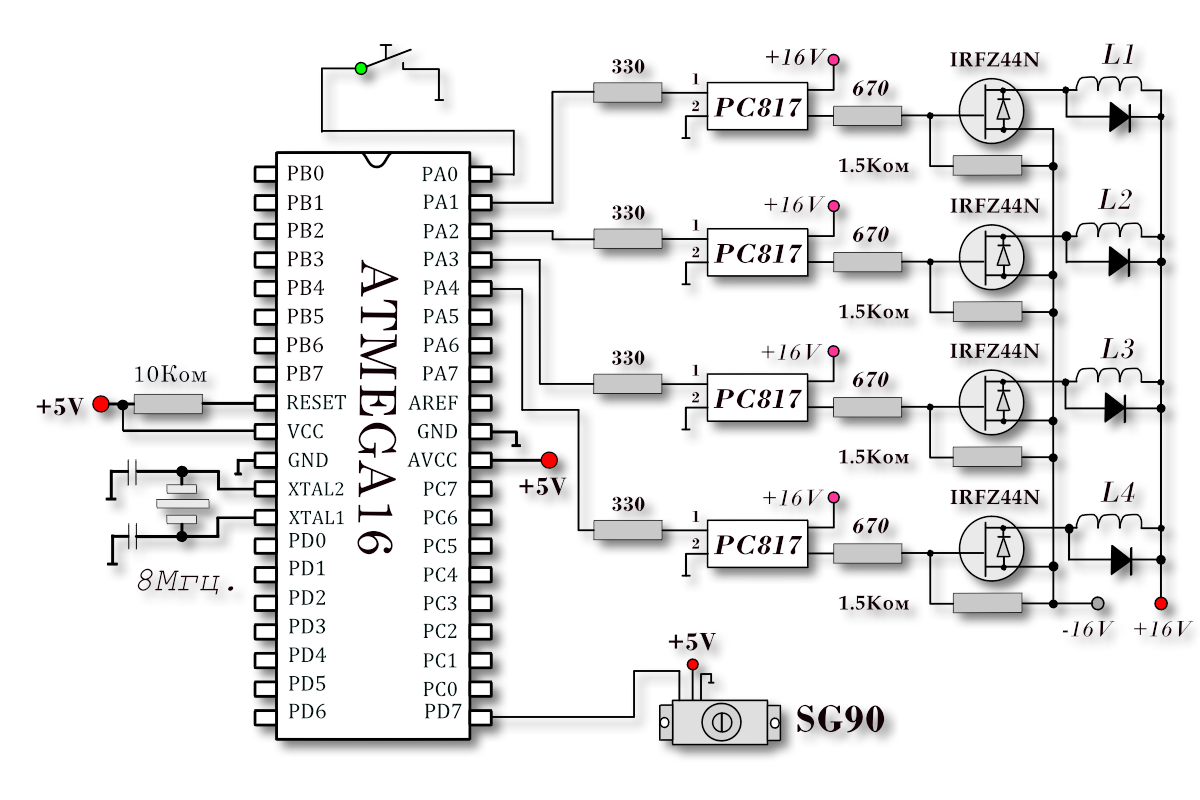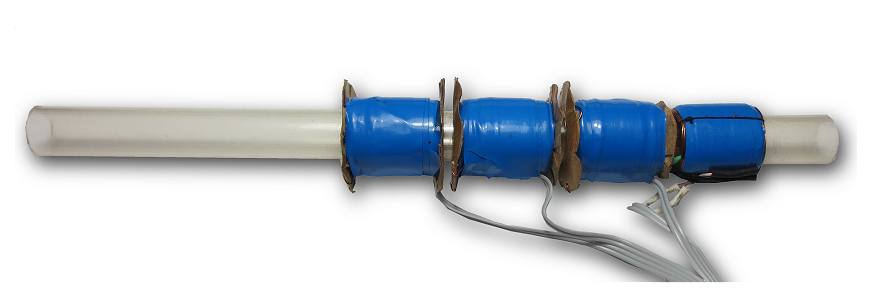Gauss electromagnetic gun on a microcontroller
Hello. In this article we will look at how to make a portable Gauss electromagnetic gun assembled using a microcontroller. Well, about the Gauss gun, I, of course, got excited, but there is no doubt that this is an electromagnetic gun. This device on a microcontroller was designed to teach beginners to program microcontrollers using the example of designing an electromagnetic gun with their own hands.

From the outset, you need to decide on the diameter and length of the barrel of the gun itself and the material from which it will be made. I used a plastic case with a diameter of 10 mm from under the mercury thermometer, since it was lying around with me. You can use any available material with non-ferromagnetic properties. These are glass, plastic, copper tube, etc. The length of the barrel may depend on the number of electromagnetic coils used. In my case, four electromagnetic coils are used, the barrel length was twenty centimeters.

')
As for the diameter of the tube used, in the process of operation the electromagnetic gun showed that it is necessary to take into account the diameter of the barrel relative to the used projectile. Simply put, the diameter of the barrel should not much exceed the diameter of the used projectile. Ideally, the barrel of an electromagnetic gun should fit under the projectile itself.
The material for the creation of shells served as the axis of the printer with a diameter of five millimeters. From this material, and were made five blanks 2.5 cm long. Although it is also possible to use steel blanks, say, from a wire or electrode - that there is.
It is necessary to pay attention to the weight of the shell itself. Weight should be as small as possible. My shells turned out a bit heavy.

Before creating this gun experiments were conducted. An empty pen paste was used as a barrel, and a needle was used as a shell. The needle easily pierced the cover of a magazine installed near the electromagnetic gun.
Since the original Gauss electromagnetic gun is built on the principle of charging a large voltage to a capacitor, about three hundred volts, for safety reasons, beginners should be fed a low voltage, about twenty volts, to beginners. Low voltage leads to the fact that the range of the projectile is not very long. But again, it all depends on the number of applied electromagnetic coils. The more electromagnetic coils are used, the greater the acceleration of the projectile in the electromagnetic gun. Also, the diameter of the barrel (the smaller the diameter of the barrel, the projectile flies farther) and the quality of the winding of the electromagnetic coils themselves. Perhaps the electromagnetic coils are the most important thing in the electromagnetic gun device, you need to pay serious attention to this in order to achieve maximum projectile flight.
I will give the parameters of my electromagnetic coils, they may be different for you. The coil is wound with a wire with a diameter of 0.2 mm. The length of the winding layer of the electromagnetic coil is two centimeters and contains six such rows. I did not isolate each new layer, but started winding a new layer onto the previous one. Due to the fact that the electromagnetic coils are powered by low voltage, you need to get the maximum quality factor of the coil. Therefore, we wind all the turns tightly to each other, turn to turn.

As for the feeder, there is no need for special explanations. Everything was soldered from waste foil textolite left over from the production of printed circuit boards. The pictures are all displayed in detail. The heart of the feeder is an SG90 servo driven by a microcontroller. You can buy here

The feed rod is made of steel bar with a diameter of 1.5 mm, at the end of the rod is sealed nut m3 for coupling with the servo. A copper wire 1.5 mm in diameter installed on both ends of the servo-driver to increase the shoulder is installed.
This simple device, assembled from scrap materials, is enough to feed a projectile into the barrel of an electromagnetic gun. The feed rod must completely exit the boot store. A cracked brass stand with an inner diameter of 3 mm and a length of 7 mm served as a guide for the feed rod. It was a pity to throw it away, and that was actually useful, as well as pieces of foil textolite.
The program for the microcontroller atmega16 was created in AtmelStudio, and is a completely open project for you. Consider some of the settings in the microcontroller program that will have to be made. For the most effective operation of the electromagnetic gun, you will need to set up in the program the operation time of each electromagnetic coil. Setup is done in order. At first you piped the first coil into the circuit, you do not connect all the others. Specify the program time (in milliseconds).
PORTA | = (1 << 1); // coil 1
_delay_ms (350); / / working hours
Stitch the microcontroller, and run the program on the microcontroller. The efforts of the coil should be enough to draw the projectile and give the initial acceleration. Having achieved maximum projectile departure, adjusting the coil operation time in the microcontroller program, connect the second coil and also adjust it in time, achieving an even longer range of the projectile. Accordingly, the first coil remains on.
PORTA | = (1 << 1); // coil 1
_delay_ms (350);
PORTA & = ~ (1 << 1);
PORTA | = (1 << 2); // coil 2
_delay_ms (150);
In this way, you configure the operation of each electromagnetic coil, connecting them in order. As the number of electromagnetic coils in the device of a Gauss electromagnetic gun increases, the speed and, accordingly, the range of the projectile should also increase.
This painstaking setting procedure for each coil can be avoided. But for this it is necessary to modernize the device of the electromagnetic gun itself, by installing sensors between electromagnetic coils to track the movement of the projectile from one coil to another. Sensors in combination with a microcontroller will not only simplify the setup process, but also increase the range of the projectile. I did not make these bells and whistles and complicate the microcontroller program. The goal was to implement an interesting and uncomplicated project using a microcontroller. How interesting it is, to judge, of course, you. To be honest, I was happy, like a child, “threshing” from this device, and my idea of a more serious device on a microcontroller matured. But this is a topic for another article.
Program and scheme - atmel-programme.clan.su/Puhka.zip

From the outset, you need to decide on the diameter and length of the barrel of the gun itself and the material from which it will be made. I used a plastic case with a diameter of 10 mm from under the mercury thermometer, since it was lying around with me. You can use any available material with non-ferromagnetic properties. These are glass, plastic, copper tube, etc. The length of the barrel may depend on the number of electromagnetic coils used. In my case, four electromagnetic coils are used, the barrel length was twenty centimeters.

')
As for the diameter of the tube used, in the process of operation the electromagnetic gun showed that it is necessary to take into account the diameter of the barrel relative to the used projectile. Simply put, the diameter of the barrel should not much exceed the diameter of the used projectile. Ideally, the barrel of an electromagnetic gun should fit under the projectile itself.
The material for the creation of shells served as the axis of the printer with a diameter of five millimeters. From this material, and were made five blanks 2.5 cm long. Although it is also possible to use steel blanks, say, from a wire or electrode - that there is.
It is necessary to pay attention to the weight of the shell itself. Weight should be as small as possible. My shells turned out a bit heavy.

Before creating this gun experiments were conducted. An empty pen paste was used as a barrel, and a needle was used as a shell. The needle easily pierced the cover of a magazine installed near the electromagnetic gun.
Since the original Gauss electromagnetic gun is built on the principle of charging a large voltage to a capacitor, about three hundred volts, for safety reasons, beginners should be fed a low voltage, about twenty volts, to beginners. Low voltage leads to the fact that the range of the projectile is not very long. But again, it all depends on the number of applied electromagnetic coils. The more electromagnetic coils are used, the greater the acceleration of the projectile in the electromagnetic gun. Also, the diameter of the barrel (the smaller the diameter of the barrel, the projectile flies farther) and the quality of the winding of the electromagnetic coils themselves. Perhaps the electromagnetic coils are the most important thing in the electromagnetic gun device, you need to pay serious attention to this in order to achieve maximum projectile flight.
I will give the parameters of my electromagnetic coils, they may be different for you. The coil is wound with a wire with a diameter of 0.2 mm. The length of the winding layer of the electromagnetic coil is two centimeters and contains six such rows. I did not isolate each new layer, but started winding a new layer onto the previous one. Due to the fact that the electromagnetic coils are powered by low voltage, you need to get the maximum quality factor of the coil. Therefore, we wind all the turns tightly to each other, turn to turn.

As for the feeder, there is no need for special explanations. Everything was soldered from waste foil textolite left over from the production of printed circuit boards. The pictures are all displayed in detail. The heart of the feeder is an SG90 servo driven by a microcontroller. You can buy here

The feed rod is made of steel bar with a diameter of 1.5 mm, at the end of the rod is sealed nut m3 for coupling with the servo. A copper wire 1.5 mm in diameter installed on both ends of the servo-driver to increase the shoulder is installed.
This simple device, assembled from scrap materials, is enough to feed a projectile into the barrel of an electromagnetic gun. The feed rod must completely exit the boot store. A cracked brass stand with an inner diameter of 3 mm and a length of 7 mm served as a guide for the feed rod. It was a pity to throw it away, and that was actually useful, as well as pieces of foil textolite.
The program for the microcontroller atmega16 was created in AtmelStudio, and is a completely open project for you. Consider some of the settings in the microcontroller program that will have to be made. For the most effective operation of the electromagnetic gun, you will need to set up in the program the operation time of each electromagnetic coil. Setup is done in order. At first you piped the first coil into the circuit, you do not connect all the others. Specify the program time (in milliseconds).
PORTA | = (1 << 1); // coil 1
_delay_ms (350); / / working hours
Stitch the microcontroller, and run the program on the microcontroller. The efforts of the coil should be enough to draw the projectile and give the initial acceleration. Having achieved maximum projectile departure, adjusting the coil operation time in the microcontroller program, connect the second coil and also adjust it in time, achieving an even longer range of the projectile. Accordingly, the first coil remains on.
PORTA | = (1 << 1); // coil 1
_delay_ms (350);
PORTA & = ~ (1 << 1);
PORTA | = (1 << 2); // coil 2
_delay_ms (150);
In this way, you configure the operation of each electromagnetic coil, connecting them in order. As the number of electromagnetic coils in the device of a Gauss electromagnetic gun increases, the speed and, accordingly, the range of the projectile should also increase.
This painstaking setting procedure for each coil can be avoided. But for this it is necessary to modernize the device of the electromagnetic gun itself, by installing sensors between electromagnetic coils to track the movement of the projectile from one coil to another. Sensors in combination with a microcontroller will not only simplify the setup process, but also increase the range of the projectile. I did not make these bells and whistles and complicate the microcontroller program. The goal was to implement an interesting and uncomplicated project using a microcontroller. How interesting it is, to judge, of course, you. To be honest, I was happy, like a child, “threshing” from this device, and my idea of a more serious device on a microcontroller matured. But this is a topic for another article.
Program and scheme - atmel-programme.clan.su/Puhka.zip
Source: https://habr.com/ru/post/253981/
All Articles